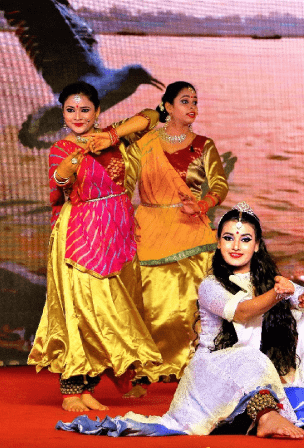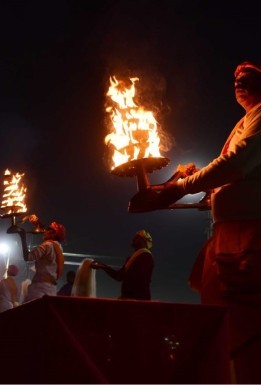Prayagraj, holds a sacred significance as the confluence point of the Ganga, Yamuna, and Saraswati rivers, making it one of the pivotal destinations during the upcoming Maha Kumbh Mela in 2025. This historic city in the state of Uttar Pradesh is a veritable treasure trove for Hindu pilgrims and history enthusiasts alike. It offers a rich tapestry of ancient temples, monuments, and various tourist attractions. At the heart of Prayagraj lies the revered Triveni Sangam, where the three holy rivers meet, an absolute must-visit for anyone attending the Maha Kumbh Mela in 2025. However, Prayagraj has much more to offer, including:
Maha Kumbh 2025, a sacred pilgrimage and celebration of faith that draws millions of devotees and travelers from all corners of the globe. As you embark on this extraordinary journey, you'll discover a multitude of attractions that make the Maha Kumbh a truly unique and awe-inspiring event.

In Daraganj locality, on the bank of the Ganga, is the Sankatmochan Hanuman Temple. It is said that Saint Samarth Guru Ramdasji had established the idol of Lord Hanuman Here. The idols of Shiva-Parvati, Ganesh, Bhairav, Durga, Kali and Navgrah are also enshrined in the premises of the temple. Nearby are Shri Ram-Janki temples and HaritMadhava temple.

Akshayvat “the indestructible Banyan tree” is a sacred fig tree mentioned in Hindu mythology, and in Hindu texts. The Akshaya Vat tree has been mentioned in great details by historians and travelers such as the Buddhist Pilgrim Hieun-tsang and the archaeologist, Alexander Cunningham. The tree is significant, for it is where Rama, Lakshman and Sitathe protagonists of the Ramayana are said to have rested during their exile from Ayodhya. Patalpuri Temple : Patalpuri Temple is one of the oldest temples in India dating back to the vedic period. This beautifully decorated underground temple is built within the Allahabad fort close to the immortal tree Akshayvat.

The Saraswati Koop refurbishment for the done Maha Kumbh Mela 2025 is a monumental initiative aimed at restoring and enhancing the spiritual significance of the sacred well. The project involves meticulous restoration efforts to preserve its historical and cultural importance, ensuring pilgrims experience a profound connection during the revered event.

It is situated near Minto Park on the west of the fort along the Yamuna River. It has a black stone lingam and statues of Ganesh and Nandi. There is a grand statue of Hanuman and an ancient peepal tree near the temple.

Associated with Sage Bharadwaj, It is a renowned religious place. During the time of Sage Bharadwaj it was famous as an educational centre. It is believed that Lord Rama visited this place with Sitaji and Lakshmanji while proceeding to Chitrakoot during his exile. At present, there are temple of Bharadwajeshwar Mahadeva, Sage Bharadwaj, TeertharajPrayag and Goddess Kali etc. Nearby is the beautiful Bharadwaj Park.

The State Pavilion project aims to showcase the diverse culture, art, and tourism attractions of various Indian states to both domestic and international tourists. The pavilion will be built around the theme of traditional festivals celebrated between Makar Sankranti and Baisakhi. It will feature 35 booths representing different states and union territories, along with a crowd holding area for visitors. To engage the public, workshops will be organized, and traditional handicrafts will be displayed in a dedicated market space. Additionally, a stage will be constructed to host cultural performances from various states. This initiative is designed to highlight India’s rich cultural diversity and heritage on a global platform, while also promoting tourism across the country.


The Kala Gram project will feature three distinct themes, showcasing various aspects of art and culture, aimed at enriching the visitor experience during the fair.

A cutting-edge water laser show, featuring advanced technology, is set to be conducted near the boat club along the Yamuna River at Kali Ghat. This initiative aims to create an engaging and visually stunning attraction, enhancing the cultural and entertainment appeal of the area for both locals and tourists.

A mesmerizing drone show featuring divine figures will be held for domestic and international tourists visiting the fairgrounds in the evening. Scheduled for January 20 and February 5, this show aims to provide an enchanting experience by displaying celestial imagery through cutting-edge technology. It is designed to enhance the spiritual atmosphere of the event while offering a visually captivating attraction for all visitors.

Thirty temporary thematic entrance gates, inspired by various themes of Kumbh and Prayag, will be constructed at the fairground, with the tender process currently underway. This initiative aims to enhance the aesthetic appeal of the fairground, creating a memorable experience for visitors by showcasing the rich cultural themes associated with Kumbh and Prayag.

The Tourism Department is undertaking the installation of façade lighting at several key locations for beautification purposes. This initiative will enhance the visual appeal of prominent landmarks, including Allahabad Fort, Shastri Bridge, Naini Bridge, Hanuman Temple, Nagvasuki Temple, Alop Shankari Temple, Shankar Viman Mandap, and Shrungverpur Dham. By illuminating these sites, the project aims to create a more inviting atmosphere for both locals and tourists, particularly during the evening hours, thereby showcasing the rich cultural heritage of the area.

One of the most profound experiences at Maha Kumbh is taking part in the holy bathing rituals at the confluence of the Ganges, Yamuna, and Saraswati rivers. Witness the spectacle of millions of pilgrims immersing themselves in the sacred waters, seeking spiritual purification and blessings.

The Akhara camps are where spiritual seekers, sadhus, and ascetics gather to discuss philosophy, engage in meditation, and share their wisdom. Explore these camps to engage in enlightening conversations and witness the ascetic lifestyle up close.

Maha Kumbh offers an unparalleled opportunity to attend spiritual discourses and satsangs led by renowned saints, gurus, and scholars. These gatherings provide profound insights into the ancient wisdom and teachings of Hinduism.

Immerse yourself in the rich cultural tapestry of India at Maha Kumbh. Enjoy classical music and dance performances, folk art exhibitions, and traditional theater. The vibrant displays of India's diverse heritage are a visual and auditory feast.

Explore the bustling bazaars, where artisans showcase their craftsmanship, from intricate jewelry to handwoven textiles. Savor the flavors of India at the food stalls, offering a diverse range of regional delicacies.

Discover inner peace and rejuvenation through yoga and meditation retreats held throughout the festival. Experienced instructors guide participants in achieving physical, mental, and spiritual harmony.

Be part of colorful processions and parades that showcase the cultural diversity of India. These processions often feature elephants, horses, chariots, and beautifully adorned participants.

Maha Kumbh 2025 places a strong emphasis on sustainability and environmental conservation. Participate in tree-planting drives, clean-up efforts, and awareness campaigns to contribute to the preservation of this sacred environment.

Marvel at the art installations and exhibitions that celebrate the spiritual and cultural heritage of India. These displays are a testament to the artistic creativity and devotion of the people.

End your day with the mesmerizing Ganga Aarti ceremony on the riverbanks. The sight of thousands of lamps illuminating the sky and the soul-stirring chants create an unforgettable spiritual experience.
Maha Kumbh 2025 is not just an event; it's a transformative journey that allows you to connect with your inner self and experience the depth of Indian spirituality and culture. Explore these attractions and make your pilgrimage to Maha Kumbh an unforgettable adventure of a lifetime.